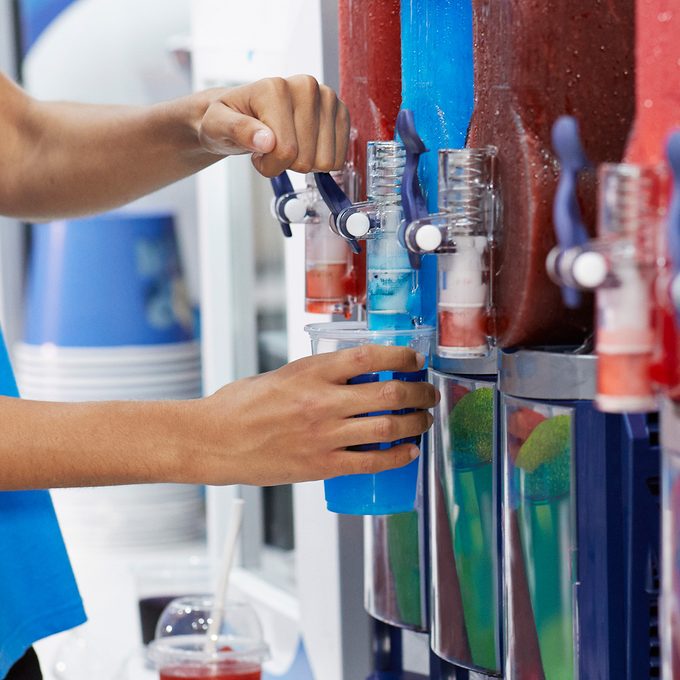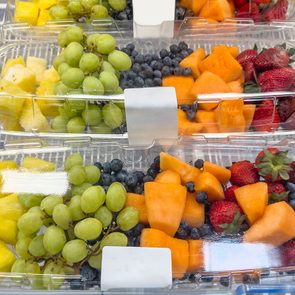Head straight for the cooler of bottled drinks instead. Trust us.

The Gross Reason Why You Should Never Get a Slushie from a Gas Station

Whether you’re on a road trip or just filling up your tank on a hot day, there’s something so enticing about a slushie from the gas station convenience store. It’s sweet, it’s refreshing and it makes you feel like a kid again.
But while you may be willing to splurge on the occasional sugar-and-calorie explosion, that gas station slushie could be hiding another potential health hazard. Read on to learn why you may want to avoid those gas station slushies this summer.
Get Reader’s Digest’s Read Up newsletter for more helpful tips, cleaning, travel, humor, tech and fun facts all week long.
What’s in a gas station slushie?
The ingredients in a gas station slushie are pretty simple. First, there’s water, which becomes ice inside the machine. Then there’s the flavored syrup, which gives the slushie both its flavor and color. The syrup is typically made with sugar (and a lot of it), which both gives the sip its sweet flavor and acts as antifreeze, helping maintain the partially frozen texture of the slushie. Finally, if you’re ordering a slushie at a gas station or convenience store, there might be carbon dioxide added as well. The carbon dioxide gives the treat its light, drinkable texture, which is what differentiates a slushie you drink from a slushie you would eat with a spoon.
Another important note: If you see slushies that are being advertised as sugar-free, that means there’s another type of sweetener being used in the flavored syrup. The sugar substitute that best replicates sugar’s antifreeze effects is glycerol, which is a sugar alcohol that was recently found to be potentially dangerous for young children. A study published earlier this year in Archives of Disease in Childhood found that glycerol in slushies can cause something called glycerol intoxication in children under 6 years old. This basically means that the child has consumed more glycerol than their body can process, leading to a drop in consciousness or dangerously low blood sugar. So, in general, it’s smart to avoid the slushie machine altogether if you have kids in tow.
What’s the problem with gas station slushies?

The main problem with gas station slushies is that the slushie machine is likely not as clean as it should be (which may be the case with the Wendy’s Frosty machine as well). First, consider this: Frozen Beverage Dispensers, a Texas-based company that claims to serve 80% of the world’s frozen beverage retailers, says the following on its website regarding its own frozen drink machines: “In fact, if you keep the exterior sanitized, some frozen drink makers can run for an entire year without turning them off or cleaning them out once. Keep the water on and the syrup and CO2 full, and your frozen machine can pour frozen drinks for a whole year before you have to do any routine maintenance on it.”
Can you imagine sipping a slushie from a machine that hasn’t been cleaned in months? That’s especially cringe-worthy when you consider that slushie machines and ice machines are breeding grounds for bacteria. Multiple local news reports from over the years—including one from a Houston news station in 2017, one from the southern Pennsylvania York Daily Record in 2018 and one from the Reno Gazette Journal earlier this year—have revealed that public health inspectors frequently cite restaurants for pink slime, black mold and white mildew in the ice machines.
The humid, dark, undisturbed environment inside an ice machine—or, say, on the bottom of the drum of a slushie machine that is never emptied—allows colonies of bacteria to grow and thrive. And these bacteria, if they make their way into your slushie, have the potential to cause vomiting, diarrhea, abdominal pain, cramps or worse.
Does this mean I can never enjoy a slushie again?
No, it doesn’t. While there’s a chance that gas station slushie machines are not being cleaned as often as they should be, that may not necessarily be true at your go-to store. Or, even if it is true, you may pop in a day or two after the machine gets cleaned, in which case you’ll be in the clear. To find out, you can ask the associate behind the counter if they know when the slushie machine was last cleaned.
If they don’t know or if you want to do some investigating on your own, take a close look around the store. Start at the drink machines and see if the dispensers, trays and exteriors look clean. Then take a peek inside other machines or cases that hold food, such as the hot dog roller grill or the case that holds the baked goods. The cleaner these look, the greater the likelihood that the inside of the slushie machine will have been cleaned relatively recently as well.
RELATED:
- You Should Avoid This Type of Food on a Cruise—Here’s Why
- The Gross Reason You Might Not Want to Eat Food If a Fly Lands on It
- This Is the Germiest Item in a Restaurant, According to a Microbiologist
Why trust us
At Reader’s Digest, we’re committed to producing high-quality content by writers with expertise and experience in their field in consultation with relevant, qualified experts. We rely on reputable primary sources, including government and professional organizations and academic institutions as well as our writers’ personal experiences where appropriate. We verify all facts and data, back them with credible sourcing and revisit them over time to ensure they remain accurate and up to date. Read more about our team, our contributors and our editorial policies.
Sources:
- Archives of Disease in Childhood: “Glycerol intoxication syndrome in young children, following the consumption of slush ice drinks”
- Frozen Beverage Dispensers: “All About Frozen Drink Machines: Guide 2023”
- Click2Houston: “Slime in ice machines: How to spot the moldy mess”
- York Daily Record: “Pink slime: That gunk on a restaurant’s soda fountain, ice maker can make you really sick”
- Reno Gazette Journal: “How dirty are restaurant ice machines, and can they make you sick?”






















